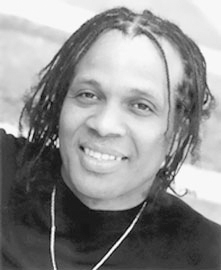An interview with Ballet Creole's Patrick Parson about the new all-male dance show Breaking Out
“Dance is very athletic, even though it’s emotional. You have to move in space, you have to jump in space, you have to run, you have to roll, you have to take somebody’s weight, lift somebody.”
- Patrick Parson, Artistic Director, Ballet Creole
As I was preparing to speak to Ballet Creole's Artistic Director, Patrick Parson, the other day for what was my second interview with Ballet Creole, I stopped to think about some of the other dance-related interviews I did in between our two conversations. There was a series of interviews for Julia Sasso's The Betrayal Project and also my recent interview with COBA, to name a couple. I also stopped to think about how much I tended to stand out at those dance show openings I was attending following those interviews.
I had never really attended any dance shows before my first experience with Ballet Creole's Glorious Soulful Messiah performance last December. But somehow, I sat there spellbound by the sheer athleticism of those dancers on stage. I wasn't just sitting for a dance show but, as was later the case with Julia Sasso's The Betrayal Project, I was witnessing an all-out carefully choreographer athletic outburst that couldn't'' leave anyone unmoved.
Needless to say, I was pretty much the only black male in the audience for these shows. There might have been one that odd time, but as Seinfeld would say, I think he was on the other team. Speaking to Patrick Parson, I was glad that we could discuss openly those instilled stereotypes about males in the dance world. It was particularly fitting that the interview was about Ballet Creole's show premiering tonight, one of Parson's own creations, Breaking Out, which represents an all-male cast. I must myself admit that while I very much enjoyed my first dance show experience with Glorious Soulful Messiah, when my male friends asked me about it later, I spent a lot more time discussing the date I took to go see it with than the art form itself. Is there anything wrong with two straight males talking about the ballet? Tough question. But Parson isn't afraid to take on the issue straight on.
Patrick Parsons said when he was dancing back home in his native land of Trinidad and Tobago, he was with a company that had more male dancers than females (12 men and 8 females). “When I came to Toronto to study dance, it was a big turn-around. Because in most of the cultural dance groups doing more professional work, you would see fewer men than females.” He goes on to say that the same phenomenon repeats itself in the dance schools. “After researching about men in dance for quite some time, I realized there was a switch with the men being involved in dance as an art form. I think it’s because when homosexuality became more public, men, particularly straight men, started to move away from the dance world.” They would not involve themselves in dance training as readily in reaction to societal stereotypes. The fathers of the household would also discourage their sons from taking part in what they would call “sissy activities,” as Parson elaborates.
Parson admits that it was even a struggle for him to get enough males to put on the Breaking Out show. Originally he wanted to have 8 men in the piece but had to settle for 6. "There aren't a lot of black men training in dance today," he says. But we go on to discuss how if you look at the history of African culture, there has always been a strong tradition of men dancing. “I think it’s an economic thing, a social thing," Parson says. "People tend to see sports as more of a male thing than dance.” But he argues: “Dance is a sport, it’s an art, it’s a physical thing. But it’s also physical with an emotion.”
Parson, as part of Ballet Creole’s mandate, goes into the schools to introduce dance to youth (he teaches at North Albion). He finds it encouraging that young boys do enjoy dancing. “But by the time they leave high school, that’s it. Because they're out in the public eye again.” While in school, dance can safely be seen as a subject, peer pressure isn’t as heavy, and young boys see it as a fun activity to do with all their friends.
“The thing about men dancing is about how they dress. A wrestler can put on tights. A sprinter can put on a tight,” Parson says. But as soon as young men are told to put on tights for dancing, they refuse. Parson fails to see the difference between the pair of tights that football players, sprinters, gymnasts and other sportsmen wear. “That’s where I get a little bit baffled and confused. But I’m trying to bring more men back into the performing art of dance.”
Info:
Ballet Creole presents "BREAKING OUT" at Premiere Dance Theatre, Harbourfront Toronto, on March 30th, 31st, and APRIL 1st at 8 PM.
BREAKING OUT is a collection of original works that examine the boundaries and stereotypes placed upon us by society.






